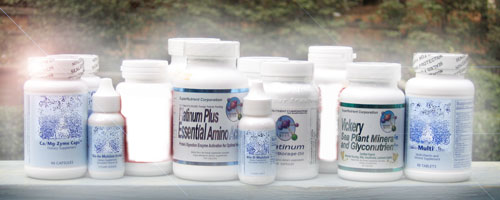Osteoporosis and Protein
Osteoporosis is defined as a condition in which bone mass has decreased due to demineralization to the point where fractures are prone to occur. This loss of bone strength happens when the normal balance between cells that regulate bone density becomes compromised through various conditions such as dietary habits or drug use that promote a low blood Ph or a lack of nutrients supporting bone density such as protein, calcium, phosphorus, vitamins D,C, and K, zinc, manganese, and copper (The bulk of the mineral structure in bone is comprised of the calcium-phosphorus compound, hydroxyapatite.) Genetic protein abnormalities can also affect bone health.1
Cells called osteoclasts and osteoblasts maintain bone density balance. The former are formed in the blood and burrow into the bone releasing calcium and other minerals into the bloodstream when they are needed; for example, to maintain a proper blood Ph. Osteoblasts are formed in the bone and will rebuild bone by filling in the places left by osteoclasts with mineral crystals of calcium and phosphorus for the hydroxyapatite compound. In a healthy person this bone density turnover is regulated in part by a number of proteins known as TNFR (tumor necrosis factor receptor) proteins. Specifically: (receptor activator of nuclear factor [kappa]B/osteoclast differentiation and activation receptor; osteoclast differentiation factor/osteoprotegerin ligand/tumor necrosis factor-related activation-induced cytokine; and osteoprotegerin/osteoclast inhibitory factor2) These proteins regulate osteoclast activity in the body. Balance is also regulated by the hormone, calcitonin, a protein produced by the thyroid which inhibits osteoclast activity and promotes osteoblast activity. This bone density protein regulation network is quite complicated and not completely understood. For example, when calcitonin is given to patients with low bone density as a osteoblast stimulator it will actually have the opposite result in just a few days because calcitonin seems to stimulate certain TNFR proteins to start osteoclast activity.3
Parathyroid hormone is another protein, 84 AA long, that regulates bone density. If plasma calcium levels drop too far, this protein stimulates iconoclast activity, freeing calcium into the blood. Osteoblasts also interact with various extra cellular proteins such as fibronectin and collagen and this interaction is known to have some, still unclear, effect on osteoblast structure, metabolism and response to stimuli4.
Osteocalcin is a bone matrix protein, abundant in mineralized bone and produced by osteoblasts, the major target cells of parathyroid hormone. (Osteocalcin, discovered in 1975, is the oldest primate protein sequence reported. In other words, modern humans have the same osteocalcin structure that Neanderthals did 75,000 years ago.5 Must be important stuff.)Osteocalcin is 49AA long, vitamin K dependent and calcium binding. It uses 3-gamma carboxyglutamic acid (Gla) in order to bind tightly to the hydroxyapatite surfaces in the bone matrix. Gla synthesis is itself dependent on a particular enzyme (protein) for its synthesis.6
Another protein that been the subject of recent study is the bone morphogenetic protein (GMP2) which has been shown to stimulate the production of osteoblasts.7 Also transcription factor proteins such as CBFA1 and osterix are involved with the stimulation of osteoblast production in bone.8
Special proteins are also required to transport nutrients like calcium and vitamin K into the bone cell, without these transport proteins the nutrients can’t get into the cell.
These are just some of the proteins involved in bone density formation and maintenance.
Bone health is obviously a complex protein-balancing act that is affected by nutrient composition and Ph factors. Without the proper minerals and vitamins we cannot make bone. If the proper Ph is not present we cannot keep bone. Proteins are involved in both the structure and regulation of bone density. Without the necessary amino acids we cannot make these proteins. If we are not breaking down our food into the basic building blocks of all proteins, amino acids, how can we maintain bone density and avoid osteoporosis?
It is said that bone loss usually begins after the age of forty when the aging process begins to tip the balance towards osteoclastic activity, but if we keep our nutrient, protein and Ph balance properly maintained we should have excellent bone health into our old age.
References:
- 1
-
Morselli B, Neuenschwander B, Perrelet R, Lippuner K., “Osteoporosis diet” Ther Umsch. 2000
Mar;57(3):152-60. S. Ralston, “Bone Anatomy and Cell Biology.” Bone Research Group. Department of Medicine
and Therapeutics. University of Aberdeen. May, 2002.
Return to article… - 2
-
Schwarz, Edward M. PhD; O’Keefe, Regis J. MD, “Breakthrough in bone: the
molecular mechanism of osteoclast/osteoblast coupling revealed.”, Current Opinion in Orthopedics.
11(5):329-335, October 2000.
Return to article… - 3
-
T Kukita, A Kukita, T Watanabe, and T Iijima, “Osteoclast differentiation
antigen, distinct from receptor activator of nuclear factor kappa B, is involved in osteoclastogenesis under
calcitonin-regulated conditions.”, Journal of Endocrinology, Vol 170, Issue 1, 175-183 Copyright ©2001 by
Society for Endocrinology
Return to article… - 4
-
E. Takai, R. Landesburg, R. Katz, C. Hung, X. Guo, “Osteoblast cell adhesion
strength and focal adhesion kinase activation on various susstrates.” BED-Vol 50, 2001, Bioengineering
Conference.
Return to article… - 5
-
C. M. Nielsen-Marsh et al. “Osteocalcin protein sequences of Neanderthals and
modern primates” PNAS, March, 2005, vol. 102 no. 12: 4409-4413.
Return to article… - 6
-
“Osteocalcin. Bone Cell Biology” Haushka Laboratory, Children’s
Hospital Research, Boston, 2004
Return to article… - 7
-
R. Farhadieh et al… “The Role of Bone Morphogenetic Proteins BMP-2 and
BMP-4 and Their Related Postreceptor Signaling System (Smads) in Distraction Osteogenesis of the Mandible”,
Journal of Craniofacial Surgery. 15(5):714-718, September 2004
Return to article… - 8
-
S. Ralston, “Bone Anatomy and Cell Biology.” Bone Research Group.
Department of Medicine and Therapeutics. University of Aberdeen. May, 2002.
Return to article…





